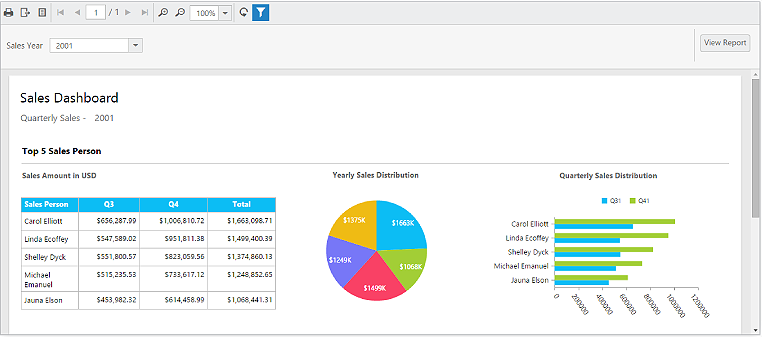Getting Started with ASP.NET Application
This section describes how to embed the Report Server report with ASP.NET application using ReportViewer.
Project Creation
Create a new ASP.NET Empty Web application project by selecting the WEB category from the listed project template in Microsoft Visual Studio IDE.
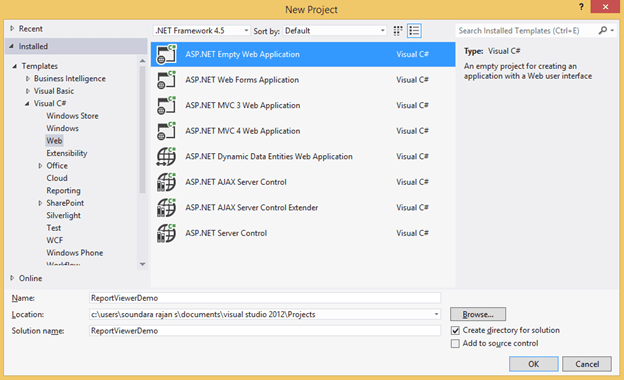
Create ASPX Page
To create a new Web Forms in the application
-
Right-Click on the project and select Add.
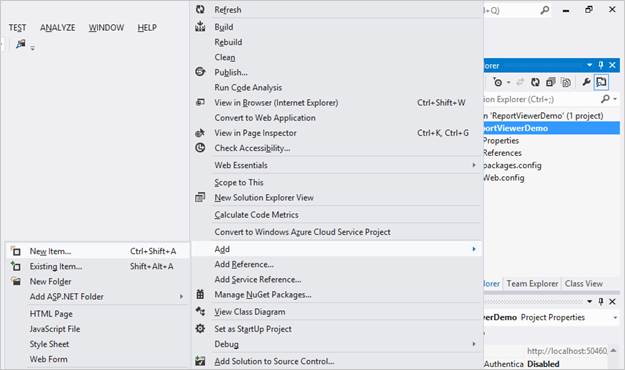
-
Click New Item and select Web Forms from the listed templates.
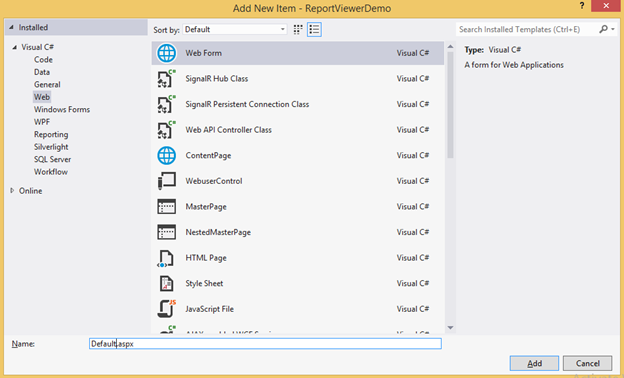
-
Name the page as Default.aspx and click OK.
Adding References, Scripts, Styles and Control in ASPX Page
Add the References, scripts, styles that are required for the ReportViewer.
Add References
-
In the Solution Explorer, right-click on the References folder and then click Add Reference.
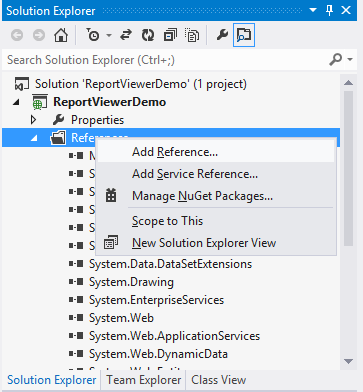
-
Add the following assemblies and click OK.
- System.Web.Routing
- System.Web.Http
- System.Web.WebHost
- System.Net.Http
- System.Net.Http.WebRequest
- System.Net.Http.Formatting
- Syncfusion.EJ
- Syncfusion.EJ.Web
- Syncfusion.Linq.Base
- Syncfusion.EJ.ReportViewer
- Syncfusion.Pdf.Base
- Syncfusion.XlsIO.Base
- Syncfusion.DocIO.Base
- Syncfusion.Shared.Wpf
- Syncfusion.Chart.Wpf
- Syncfusion.Gauge.Wpf
- Syncfusion.SfMaps.Wpf
NOTE
You can get the above assemblies from the installed location %localappdata%\Syncfusion\ReportsSDK\Samples\Common\Assemblies. Refer System.Web.Http, System.Web.Http.WebHost, System.Net.Http.WebRequest and System.Net.Http.Formatting assemblies from the NuGet package installed location %localappdata%\Syncfusion\ReportsSDK\Samples\Common\nuget.
Add Scripts and Styles
Add the script files and CSS files in the <title> tag of the Default.aspx page.
<link href="https://cdn.syncfusion.com/reportplatform/3.2.0.40/js/themes/flat-azure/ej.reportviewer.all.min.css" rel="stylesheet"/>
<script src="https://code.jquery.com/jquery-1.11.3.min.js" type="text/javascript"></script>
<script src="https://cdn.syncfusion.com/reportplatform/3.2.0.40/js/scripts/web/ej.reportviewer.all.min.js" type="text/javascript"></script>NOTE
Use the above code example while adding scripts and styles. Refer the themes and scripts from the installed location %localappdata%\Syncfusion\ReportsSDK\Samples\Common\Html
Registering Assemblies within the Web.config file
In your application’s web.config file, add the below assembly information within the <assemblies> tag and <controls> tag.
<system.web>
<compilation debug="true" targetFramework="4.5">
<assemblies>
<add assembly="Syncfusion.EJ, Version=13.4450.0.54, Culture=neutral, PublicKeyToken=3d67ed1f87d44c89"/>
<add assembly="Syncfusion.EJ.Web, Version=13.4450.0.54, Culture=neutral, PublicKeyToken=3d67ed1f87d44c89"/>
<add assembly="Syncfusion.EJ.ReportViewer, Version=13.4450.0.54, Culture=neutral, PublicKeyToken=3d67ed1f87d44c89"/>
</assemblies>
</compilation>
<pages validateRequest="false">
<controls>
<add namespace="Syncfusion.JavaScript.Web" assembly="Syncfusion.EJ.Web" tagPrefix="ej"/>
<add namespace="Syncfusion.JavaScript.Web" assembly="Syncfusion.EJ" tagPrefix="ej"/>
<add namespace="Syncfusion.JavaScript.DataVisualization.Models" assembly="Syncfusion.EJ" tagPrefix="ej"/>
<add namespace="Syncfusion.JavaScript.Models" assembly="Syncfusion.EJ" tagPrefix="ej"/>
</controls>
</pages>
</system.web>Control Initialization
Initialize ReportViewer by using the following code example in the <body> tag of the Default.aspx page.
<!DOCTYPE html>
<html xmlns="http://www.w3.org/1999/xhtml">
<head runat="server">
<title></title>
</head>
<body>
<form id="form1" runat="server">
<ej:ReportViewer ID="Viewer" runat="server"/>
</form>
</body>
</html>Load Report Server Report
We have to use built-in Report Server service to load the Report Server reports along with server capabilities in ReportViewer. You have to use ReportPath, ReportServiceUrl and ServiceAuthorizationToken properties with ReportViewer as like following to show the Report Server report within application.
<form id="form1" runat="server" onsubmit="return false" style="overflow: hidden; padding:0; margin: 0;height:100%;width:100%;">
<ej:ReportViewer ID="ReportViewer1" runat="server" ReportPath="/Sample Reports/Company Sales" ReportServiceUrl="http://reportserver.syncfusion.com/ReportService/api/Viewer"/>
</form>NOTE
In case, if we have to load the reportPath using guid instead of report location then we have a support to set guid of the report in
ReportPathas like as ‘ReportPath=”91f24bf1-e537-4488-b19f-b37f77481d00”’.
Service Authorization
In order to use the Report Server built-in report service, which need to be authenticated using Report Server authorization token. So, we have to set ServiceAuthorizationToken by getting the authorization token from server like below.
using Newtonsoft.Json;
using System;
using System.Collections.Generic;
using System.Linq;
using System.Net.Http;
using System.Web;
using System.Web.UI;
using System.Web.UI.WebControls;
namespace ReportServerSample
{
public partial class Default : System.Web.UI.Page
{
protected void Page_Load(object sender, EventArgs e)
{
this.ReportViewer1.ServiceAuthorizationToken = this.GenerateToken("http://reportserver.syncfusion.com/", "guest", "demo");
}
public string GenerateToken(string serverUrl, string userName, string password)
{
using (var client = new HttpClient())
{
client.BaseAddress = new Uri(serverUrl);
client.DefaultRequestHeaders.Accept.Clear();
var content = new FormUrlEncodedContent(new[]
{
new KeyValuePair<string, string>("grant_type", "password"),
new KeyValuePair<string, string>("username", userName),
new KeyValuePair<string, string>("password", password)
});
var result = client.PostAsync("/api/Token", content).Result;
string resultContent = result.Content.ReadAsStringAsync().Result;
var token = JsonConvert.DeserializeObject<Token>(resultContent);
return token.token_type + " " + token.access_token;
}
}
}
public class Token
{
public string access_token { get; set; }
public string token_type { get; set; }
public string expires_in { get; set; }
public string userName { get; set; }
public string serverUrl { get; set; }
public string password { get; set; }
}
}Following screenshot displays reports from Report Server with help of configured external Reporting Server.
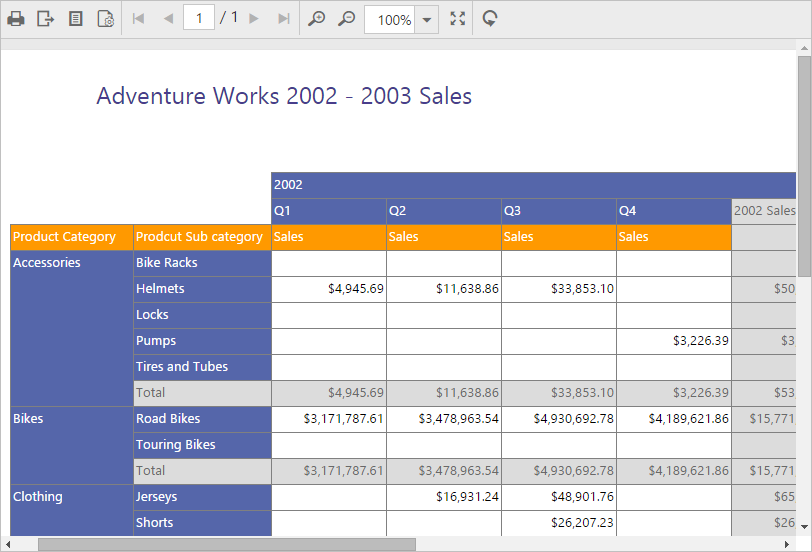
Load RDL Report
ReportViewer supports to load local RDL files. The following steps help you to load reports from local path.
Set the ReportPath, ProcessingMode and ReportServiceUrl to ReportViewer.
<form id="form1" runat="server">
<div style="height: 650px;width: 950px;min-height:404px;">
<ej:ReportViewer runat="server" ID="viewer" ReportPath="~/App_Data/Sales Dashboard.rdl" ProcessingMode="Remote" ReportServiceUrl="/api/ReportApi"/>
</div>
</form>Add WebAPI controller for ReportViewer
The ASP.NET ReportViewer uses WebApi services to process the report file and get the request from control.
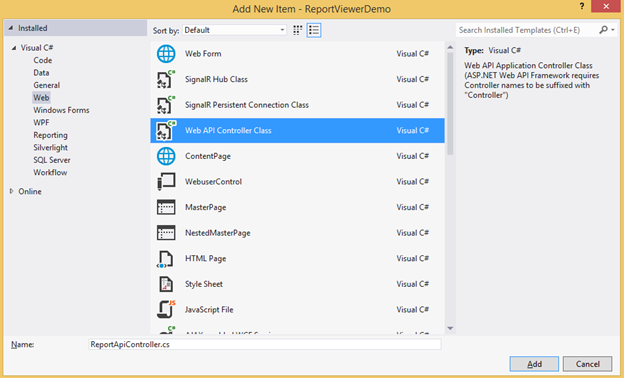
IReportController
The ApiController inherits the IReportController and you can add the following code example to its methods definition in order to process the report file. The interface IReportController contains the required actions and helper methods declaration to process the report. The ReportHelper class contains helper methods that helps to process Post/Get request from control and return the response to control.
using Syncfusion.EJ.ReportViewer;
using System;
using System.Collections.Generic;
using System.Linq;
using System.Net;
using System.Net.Http;
using System.Web.Http;
namespace ReportViewerDemo
{
public class ReportApiController : ApiController, IReportController
{
//Post action for processing the rdl/rdlc report
public object PostReportAction(Dictionary<string, object> jsonResult)
{
return ReportHelper.ProcessReport(jsonResult, this);
}
//Get action for getting resources from the report
[System.Web.Http.ActionName("GetResource")]
[AcceptVerbs("GET")]
public object GetResource(string key, string resourcetype, bool isPrint)
{
return ReportHelper.GetResource(key, resourcetype, isPrint);
}
//Method will be called when initialize the report options before start processing the report
public void OnInitReportOptions(ReportViewerOptions reportOption)
{
//You can update report options here
}
//Method will be called when reported is loaded
public void OnReportLoaded(ReportViewerOptions reportOption)
{
//You can update report options here
}
}
}WebAPI Routing
1 Right-click the project and select Add and select Global.asax file from the listed templates.
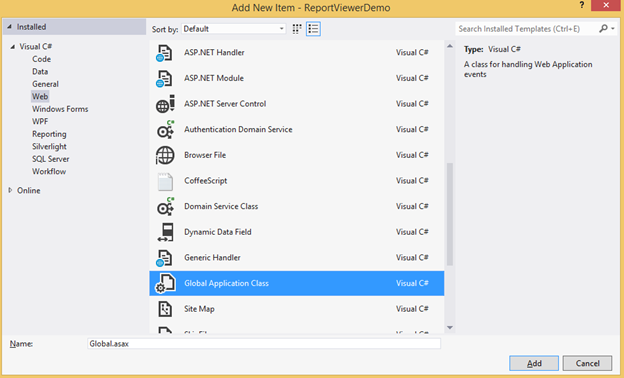
2 You can route the WebAPI in Application_Start event into Global.asax file as follows.
using System;
using System.Collections.Generic;
using System.Linq;
using System.Web;
using System.Web.Security;
using System.Web.SessionState;
using System.Web.Http;
namespace ReportViewerDemo
{
public class Global: System.Web.HttpApplication
{
protected void Application_Start(object sender, EventArgs e)
{
System.Web.Http.GlobalConfiguration.Configuration.Routes.MapHttpRoute(
name: "DefaultApi",
routeTemplate: "api/{controller}/{action}/{id}",
defaults: new { id = RouteParameter.Optional });
}
}
}3 Run the sample application and you can see the ReportViewer on the page as displayed in the following screenshot.
